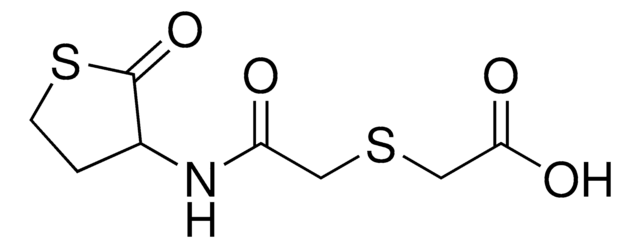T9652
Terfenadine
≥97.5% (HPLC), powder, H1 histamine receptor antagonist
Synonyme(s) :
α-[4-(1,1-Dimethylethyl)phenyl]-4-(hydroxydiphenylmethyl)-1-piperidinebutanol
About This Item
Produits recommandés
product name
Terfenadine,
Niveau de qualité
Solubilité
chloroform: soluble 250 mg plus 5 ml of solvent, clear to very slightly hazy, colorless to faintly yellow
H2O: soluble 0.01 mg/mL at 30 °C
1 M HCl: soluble 0.12 mg/mL at 30 °C
hexane: soluble 0.34 mg/mL at 30 °C
0.1 M tartaric acid: soluble 0.45 mg/mL
0.1 M citric acid: soluble 1.1 mg/mL
methanol: soluble 37.5 mg/mL at 30 °C
ethanol: soluble in salt form 37.8 mg/mL at 30 °C
Auteur
Sanofi Aventis
Température de stockage
2-8°C
Chaîne SMILES
CC(C)(C)c1ccc(cc1)C(O)CCCN2CCC(CC2)C(O)(c3ccccc3)c4ccccc4
InChI
1S/C32H41NO2/c1-31(2,3)26-18-16-25(17-19-26)30(34)15-10-22-33-23-20-29(21-24-33)32(35,27-11-6-4-7-12-27)28-13-8-5-9-14-28/h4-9,11-14,16-19,29-30,34-35H,10,15,20-24H2,1-3H3
Clé InChI
GUGOEEXESWIERI-UHFFFAOYSA-N
Informations sur le gène
human ... ABCB1(5243) , CYP2C8(1558) , CYP3A4(1576) , HRH1(3269) , IL4(3565) , IL5(3567) , KCNH1(3756) , KCNH2(3757)
mouse ... Abcb1a(18671) , Abcb1b(18669)
rat ... Hrh1(24448)
Vous recherchez des produits similaires ? Visite Guide de comparaison des produits
Application
Actions biochimiques/physiologiques
Caractéristiques et avantages
Notes préparatoires
Mentions de danger
Conseils de prudence
Classification des risques
Aquatic Chronic 4
Code de la classe de stockage
11 - Combustible Solids
Classe de danger pour l'eau (WGK)
WGK 2
Point d'éclair (°F)
Not applicable
Point d'éclair (°C)
Not applicable
Certificats d'analyse (COA)
Recherchez un Certificats d'analyse (COA) en saisissant le numéro de lot du produit. Les numéros de lot figurent sur l'étiquette du produit après les mots "Lot" ou "Batch".
Déjà en possession de ce produit ?
Retrouvez la documentation relative aux produits que vous avez récemment achetés dans la Bibliothèque de documents.
Les clients ont également consulté
Contenu apparenté
Discover Bioactive Small Molecules for ADME/Tox
Notre équipe de scientifiques dispose d'une expérience dans tous les secteurs de la recherche, notamment en sciences de la vie, science des matériaux, synthèse chimique, chromatographie, analyse et dans de nombreux autres domaines..
Contacter notre Service technique











